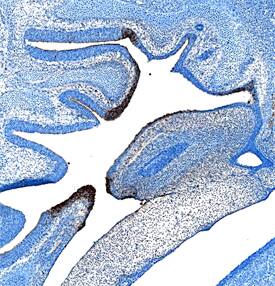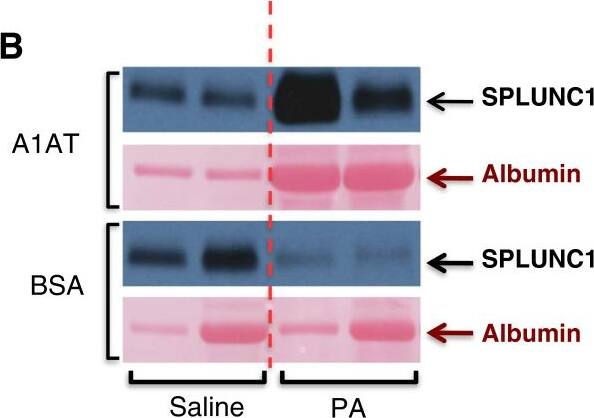Mouse PLUNC Antibody
R&D Systems, part of Bio-Techne | Catalog # AF4274


Key Product Details
Validated by
Species Reactivity
Validated:
Cited:
Applications
Validated:
Cited:
Label
Antibody Source
Product Specifications
Immunogen
Ala59-Val278
Accession # NP_035256
Specificity
Clonality
Host
Isotype
Scientific Data Images for Mouse PLUNC Antibody
Detection of Mouse PLUNC by Western Blot.
Western blot shows lysates of mouse lung tissue. PVDF membrane was probed with 1 µg/mL of Sheep Anti-Mouse PLUNC Antigen Affinity-purified Polyclonal Antibody (Catalog # AF4274) followed by HRP-conjugated Anti-Sheep IgG Secondary Antibody (Catalog # HAF016). A specific band was detected for PLUNC at approximately 30kDa (as indicated). This experiment was conducted under reducing conditions and using Immunoblot Buffer Group 8.PLUNC in Mouse Embryo.
PLUNC was detected in immersion fixed frozen sections of mouse embryo nose (13 d.p.c.) using Sheep Anti-Mouse PLUNC Antigen Affinity-purified Polyclonal Antibody (Catalog # AF4274) at 1.7 µg/mL overnight at 4 °C. Tissue was stained using the Anti-Sheep HRP-DAB Cell & Tissue Staining Kit (brown; Catalog # CTS019) and counterstained with hematoxylin (blue). Specific staining was localized to olfactory epithelium. View our protocol for Chromogenic IHC Staining of Frozen Tissue Sections.Detection of Mouse PLUNC by Western Blot
A1AT treatment enhances SPLUNC1 and reduces NE activity in bronchoalveolar lavage (BAL) fluid of PA-infected WT mice. PA-infected mice were treated with A1AT for 22 hrs and sacrificed after 24 hrs of infection as described in Materials and Methods. Quantitative analysis (A) and representative image (B) of BAL fluid SPLUNC1 Western blot were shown to demonstrate the therapeutic effect of A1AT treatment. The two lanes of Western blot image under saline or PA treatment represent SPLUNC1 data from two different mice. NE activity (C) was examined by an NE activity assay. N = 4 – 7 mice per group. The vertical dotted red line in Figure 2B separates the saline group from the PA infection group. NS indicates no significant differences. Data are expressed as means ± SEM. Image collected and cropped by CiteAb from the following publication (https://respiratory-research.biomedcentral.com/articles/10.1186/1465-9921-14-122), licensed under a CC-BY license. Not internally tested by R&D Systems.Applications for Mouse PLUNC Antibody
Immunohistochemistry
Sample: Immersion fixed frozen cross-sections of mouse embryo nose (13 d.p.c.)
Western Blot
Sample: Mouse lung tissue
Reviewed Applications
Read 1 review rated 5 using AF4274 in the following applications:
Formulation, Preparation, and Storage
Purification
Reconstitution
Formulation
Shipping
Stability & Storage
- 12 months from date of receipt, -20 to -70 °C as supplied.
- 1 month, 2 to 8 °C under sterile conditions after reconstitution.
- 6 months, -20 to -70 °C under sterile conditions after reconstitution.
Background: PLUNC
PLUNC (Palate, lung, and nasal epithelium clone; also SPLUNC1) is a 25-30 kDa member of the PLUNC family, BPI/PLUNC/LBP superfamily of proteins. PLUNC is a secreted glycoprotein that is expressed by both adult and embryonic respiratory epithelium in the nose, trachea and bronchi/primary bronchioles. It serves as a natural antibacterial polypeptide in the respiratory system. Mature mouse PLUNC is 259 amino acids (aa) in length. It contains four, six-amino acid repeats (GxxLPL) over aa 23-52. There is reportedly one splice variant that shows a 28 aa substitution for the C-terminal 45 amino acids (aa 234-278). Over aa 59-278, mouse PLUNC shares 91% and 75% aa identity with rat and human PLUNC, respectively.
Long Name
Alternate Names
Entrez Gene IDs
Gene Symbol
UniProt
Additional PLUNC Products
Product Documents for Mouse PLUNC Antibody
Product Specific Notices for Mouse PLUNC Antibody
For research use only


